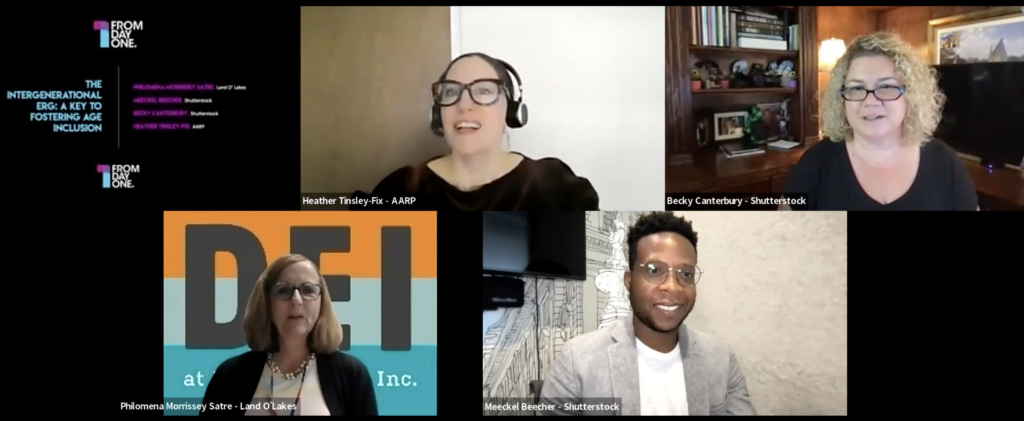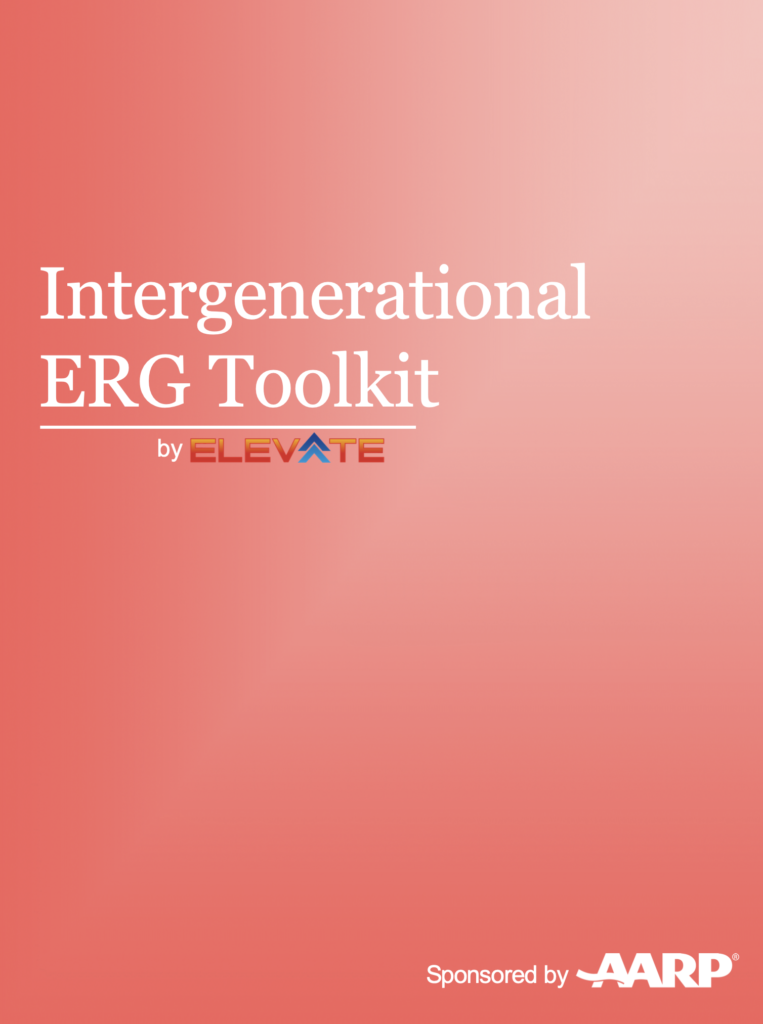A Key to Fostering Age Inclusion: the Intergenerational Resource Group


About two years ago, Becky Canterbury, a senior delivery manager at Shutterstock, the photo and media agency, was asked by a friend to serve as their job reference during an application process. The job applicant asked Canterbury to sit for an interview with a representative of a company to which they were applying.
“This individual just happened to be later in their career, a little bit older than myself,” Canterbury said of her friend. “Well, the questions of the recruiter were all around age: ‘Did this person still have the ability to work hard and work the required hours?’ ‘Could they keep up with their peers?’ It was all very age-based.”
Upset, Canterbury told her friend she was disturbed by the line of questioning from the recruiter. It also, in a way, radicalized her. “It just made me really angry and realize that we can make an impact if we start getting involved in getting more visibility out there” about age inclusion, Canterbury said.
Shortly thereafter, Shutterstock leadership sent word out that the company was seeking volunteers to be part of a new employee resource group (ERG). It would be dubbed “Seasons,” and would focus on age. Canterbury signed up because the effort “spoke to me,” she said. “This was a real chance to make an impact, both at Shutterstock, but also potentially outward,” Canterbury said. “So I joined a bunch of like-minded individuals, and the group spanned ages. It wasn’t just an older group; we had all different individuals that were part of it.”
She told her story during a recent From Day One webinar, “The Intergenerational ERG: A Key to Fostering Age Inclusion.” Moderated by Heather Tinsley-Fix, senior advisor for AARP, the event’s sponsor, the conversation explored the business benefits of diversity, equity and inclusion (DEI) initiatives, namely those centered around age, as well as some approaches organizations can take to execute them.
Today, there are Shutterstock ERGs centered around a range of employee backgrounds, and they’re not alone in such efforts. A growing number of employers are embracing more expansive definitions of DEI, investing in initiatives to help improve broad-spectrum demographic representation across their organizations.
Yet while many perceive DEI programming as a category for HR to handle, Shutterstock thinks differently. “It should be embedded across our company,” said Meeckel Beecher, global head of DEI at Shutterstock. “So it’s not just going to be seen as an HR function, but it’s a way of operating as a company.”

The Shutterstock approach to DEI is built on three pillars, Beecher said. “Inclusive culture” refers to the company’s wish to see people “show up at work and be authentic,” he explained. “Recruitment and retention” is symbolic of the company’s concerted effort to hire, retain and promote diverse talent. “Business and community,” the third pillar, represents Shutterstock’s commitment to growth and sustainability in business, while ensuring its workers feel part of the entire team, all with that shared purpose.
To help cultivate this environment, Shutterstock’s ERGs focus on elevating the voices of diverse employee subgroups. Beecher described these ERG members as “the internal experts or people with the lived experiences that [some leaders] might not have,” who provide “feedback on how we’re doing things.”
He also said the ERGs are not in place to “fix” issues related to DEI. Instead, they’re tasked with simply identifying points of concern. It’s up to company leaders and the workplace community at large to make actual changes.
Shutterstock, a photography platform for creatives and publishers, has also partnered with the American Society on Aging, Beecher said, “to ensure that the content that we have on our platform is actually representative of the communities that they are referencing.” Shutterstock wants to make sure stereotypes around aging don’t turn up in the photos it offers. The company looks to avoid singular stories that focus entirely on negative elements of aging, like sickliness and a lack of mobility. So the company’s partnership with the ASA helped launch a fund to create authentic representations of aging, with the help of three artists tasked with creating a range of stories about aging.
In tandem with the ASA, Shutterstock also generated a guidebook for its creative partners, urging them to explore a spectrum of possibilities in aging stories and images. Throughout that process, Shutterstock relied on its Seasons ERG, Beecher said, for “thought leadership” and even some “pressure”–the good kind–to deliver results.
Land O’Lakes, the member-owned agribusiness cooperative, is another organization that has bought into the benefits of ERGs, fostering 11 throughout the company, including one titled “Aging Successfully.” Each of them has a dedicated recruiter to carry out the company’s intentional mission toward optimizing staff diversity, according to Philomena Morrissey Satre, the organization’s director of diversity and inclusion and strategic partnerships. The company’s leaders seek advice from the ERGs on a host of issues, like how to ensure remote workers in rural areas can perform well even where broadband internet access might not be so stable.
The company’s leadership recently worked with its benefits division on rolling out a phased retirement benefit for its employees. Before finalizing the offering, however, benefits leaders chatted with its intergenerational ERG about what it should look like, what might be missing from it.
And Land O’Lakes is not shy about promoting these DEI efforts far and wide. “We give visibility to these amazing things that are happening,” Morrissey Satre said. “We partner closely with communications to say, ‘Hey, we have this amazing story,’ or ‘Look at what’s happening around the organization, and the impact that's being made.’ Because then that kind of creates a movement, that gets other people excited to say, ‘I want to join that group.’”
Do companies see dividends from these efforts, including those centered around age diversity?
“Age inclusion is good for business,” Tinsley-Fix said. According to data from studies conducted by the Organization for Economic Cooperation and Development (OECD), cited by Tinsley-Fix in the conversation, a 10% increase in the proportion of team members aged 50 or older can generate gains of slightly more than one year of growth. This is helped by a 4% lower rate of turnover with that boost in age diversity among staff, as well as an increase in productivity of more than 1%.
“The increase in productivity actually helps both older and younger workers,” Tinsley-Fix said. “They found that the youngest workers of the workforce–those under age 35–are the least productive comparatively, but they experienced productivity gains when they’re working with older workers.”

To help companies build ERGs that can help fulfill DEI goals, while tearing down ageist stereotypes harmful to company culture and a hindrance of performance, AARP recently published an Intergenerational ERG Toolkit. It provides data on the benefits of intergenerational ERGs, the steps on how organizations can build them from scratch, and information on how teams can optimize those that may already be in place. “It helps you really assess your ERGs and sort of stretch your thinking on them,” Tinsley-Fix said.
The traditional model of ERGs positions them as “internally focused safe spaces and places to celebrate culture and identity,” Tinsley-Fix continued. “And those things are still extremely important, but they also can evolve towards having strategic alignment with your organizational goals as well as external involvement, such as with your customers, with your community, and with the marketplace in general.”
As the panel discussion came to a close, a question arose from the audience: “If the company is already intergenerational, why do I still need an intergenerational ERG?” Becky Canterbury from Shutterstock answered energetically.
“Ageism and age isn’t necessarily recognized as something that people need to look at and address. But those biases exist, so why not start getting the groups to work together, to have the conversations to bridge those gaps?” she asked. “Leaders might have an issue they don’t necessarily know about, so why not take advantage of a group of people who want to interact, who want to help with internships, who want to help with mentorship and recruiting? Why not take advantage of that if they’re willing to do it?”
Editor’s note: From Day One thanks our partner who sponsored this webinar, AARP.
Michael Stahl is a New York City-based freelance journalist, writer, and editor. You can read more of his work at MichaelStahlWrites.com, follow him on Twitter @MichaelRStahl, and order his first book, the autobiography of Major League Baseball pitcher Bartolo Colón, at Abrams Books.
The From Day One Newsletter is a monthly roundup of articles, features, and editorials on innovative ways for companies to forge stronger relationships with their employees, customers, and communities.